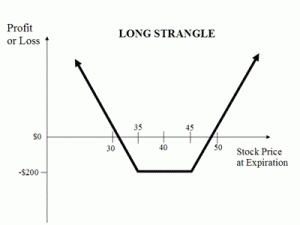The Long Strangle, or simply the Strangle, is a volatile option trading strategy that profits when the stock goes up or down strongly. The Strangle is a cousin of the Long Straddle and the Long Gut, making up a family of basic volatile options strategies. Learning the Straddle first makes the Strangle easy to understand.
The long strangle is simply the simultaneous purchase of a long call and a long put on the same underlying security with both options having the same expiration but where the put strike price is lower than the call strike price. Because the position includes both a long call and a long put, the investor using a long strangle should have a complete understanding of the risks and rewards associated with both long calls and long puts.
Unlimited Profit Potential
Large gains for the long strangle option strategy is attainable when the underlying stock price makes a very strong move either upwards or downwards at expiration.
The formula for calculating profit is given below:
- Maximum Profit = Unlimited
- Profit Achieved When Price of Underlying > Strike Price of Long Call + Net Premium Paid OR Price of Underlying < Strike Price of Long Put – Net Premium Paid
- Profit = Price of Underlying – Strike Price of Long Call – Net Premium Paid OR Strike Price of Long Put – Price of Underlying – Net Premium Paid
When to use: When you are bullish on volatility but are unsure of market direction.
A long strangle is similar to a straddle except the strike prices are further apart, which lowers the cost of putting on the spread but also widens the gap needed for the market to rise/fall beyond in order to be profitable.
Like long straddles, buying strangles is best when implied volatility is low or you expect a large movement of market price in either direction.
